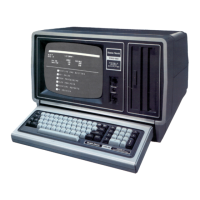password for the copies
to
work.
If
you
specify the wrong password,
an
error
is
displayed
and
the JCL aborts.
Substitution fields
can
also
be
concatenated, or added together, to
create new fields. For example:
• ADD/JCL
COPY
#F#/#E#:0
:1
copy
#F1#/#E#:0
:1
/ /
D(
IT
This example uses two substitution fields, one for the filename and
one for the extension.
If
you issue the
DO
command:
DO
ADD
(F =
SO
RT ,E =CM0 ,F 1=
SO
RT1 )
(ENTER)
the following SYSTEM/JCL file results after compiling:
• ADD/JCL
copy
SORT/CMD:0
:1
copy
SORT1/CMD:0
:1
//D(IT
As
in
previous examples, the IIIF
and
IIASSIGN macros could
be
used to allow a single token
to
select the
F,
F1,
and E tokens.
Combining
Files
Most of the JCL examples
in
the previous sections have been very
short.
In
a practical operating environment, this
is
often the case.
However, each of these small files is taking
up
the minimum disk
allocation of one gran
and
using one directory entry.
To combine small files
and
save disk space, use the Label feature of
JCL.
You
can also use the IIINCLUDE macro
to
duplicate a JCL file
inside of another JCL file, without having to retype the lines.
Using
IIINCLUDE
The IIINCLUDE macro
is
used
to
merge together two or more JCL
files during the compile phase. The syntax is:
//INCLUDE
filespec
filespec
is
a JCL file.
This command
is
similar
to
specifying the filespec
in
a
DO
command
line. However,
you
cannot enter tokens or other informa1ion after the
filespec.
If
you need
to
pass tokens
to
the included program, they will have to
be
established
in
the program that
is
doing the IIINCLUDE.
A-23

